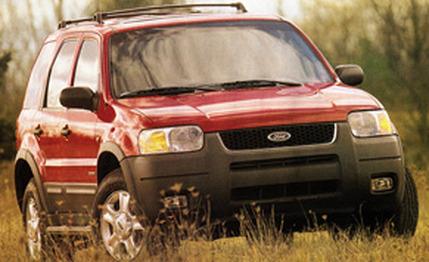 Road Test
Road Test
Our initial expectations for the Ford Escape were modest. Another small SUV? Yawn.
Certainly, Ford needed a vehicle to fill the gap below the Explorer, and we suspected it would be amusingly competent like the Suzuki Grand Vitara or maybe interesting like the single-mindedly demographic-targeted Nissan Xterra.
Then we learned that Mazda would be heavily involved in the design--the company does, after all, get a version called the Tribute, which we previewed in the May issue--and that Ford would offer the Escape with the more powerful of the two 3.0-liter V-6s found in the Taurus: the 200-hp, 24-valve Duratec. We stopped yawning.
But we were not expecting a vehicle as good as the Escape, which is shaping up to be the automotive surprise of 2000. Although the base front-drive Escape is saddled with the Focus's 130-hp, 2.0-liter Zetec four-cylinder, it is, at least, inexpensive. But add that optional V-6 and its abundant 200 horsepower and 200 pound-feet of torque, and you have our attention. With sharp handling, a comfortable, roomy, and thoughtfully designed interior, and a brisk quarter-mile time of 16.8 seconds at 83 mph, the Escape XLT might be the smartest SUV on the market.
Its dimensions feel just right, even though it is shorter than the Honda CR-V in two major areas. The Escape's 103.1-inch wheelbase is a 10th of an inch shorter, and the 173-inch overall length is 4.6 inches shorter. Yet the Escape feels larger than a CR-V. Rear-seat room is generous, yet the CR-V has one more cubic foot of rear-seat space. With the rear seats up, there is 33 cubic feet of storage space; with the seats folded down, a whopping 63 cubic feet is available (vs. the CR-V's 30 and 67). The rear window raises, or the whole rear hatch raises. This is a big little SUV.
Indeed, our test Escape XLT didn't give us much to complain about. There is more wind noise--seeming to emanate from the rearview mirrors, sunroof, roof rack, and possibly the outside step bars--than there ought to be, and the P235/70TR-16 Firestone Wilderness HT radials, although certainly competent in the traction department, generate quite a bit of road noise.
Although the model with the manual transmission has a floor shifter, the automatic transmission (Ford's slick CD4E four-speed, mandatory with the V-6) uses a long-traveling column shift that is awkward to use. And below that shifter, the ignition-key slot is hidden and hard to locate by touch, but owners should be able to adjust to it.
And although we recognize the fact that the Escape is available with 15- or 16-inch wheels, it's a bit annoying that the spare tire located beneath the floor in the rear is a 17-inch temporary tire and wheel that takes up nearly as much space as a genuine nontemporary spare would. We give extra points--mentally, anyway0--to automakers who manage to include a matching tire and wheel as a spare. Granted, with the Escape's three available tire-and-wheel combinations, that would be a bit of a challenge here, but it does not seem insurmountable.
There's plenty of good stuff. The styling is unique, handsome, and unmistakably Ford truck, although it lacks the rugged look of, say, the Nissan Xterra. And it should: The truck-based body-on-frame Xterra is a more logical choice for the Rubicon Trail, but its spindly handling and stiff ride make it less comfortable than the unibody Escape to drive on the road to the Rubicon.
The Escape's relatively conventional independent suspension offers an excellent compromise between a smooth ride and crisp handling. The Escape lacks the tipsy feel and twitchy steering that have long afflicted the Explorer; that steering, although quick, never seems abrupt. The brakes, in the one-word description of tester Frank Markus, are "phenomenal." The ABS-equipped front-disc, rear-drum binders halted the 3550-pound Escape from 70 mph in just 171 commendably undramatic feet--besting all other production SUVs we've tested. The last Nissan Xterra we tested took 199 feet, and we thought that was an acceptably short distance.